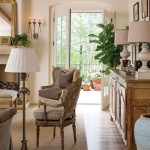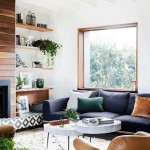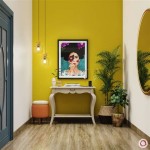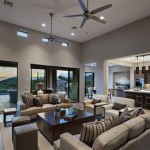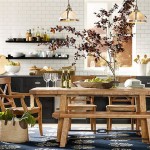Ways to Decorate a Dining Room
The dining room is a central space in many homes, serving not only as a place for meals but also as a gathering spot for family and friends. Effective dining room decoration involves a careful consideration of factors such as space, lighting, furniture, and personal style. This article will explore different approaches to enhance the aesthetic appeal and functionality of a dining room.
Selecting a Dining Table and Chairs
The dining table is often the focal point of the room. When selecting a table, its size should be proportional to the dimensions of the room. A table that is too large can make the room feel cramped, while a table that is too small may appear insignificant. Common table shapes include rectangular, square, round, and oval. Rectangular tables are well-suited for larger rooms, while round tables can create a more intimate setting, particularly in smaller spaces. The material of the table should also be considered. Wood is a classic choice, offering durability and warmth. Glass tables can create a more modern and open feel, while metal tables can add an industrial touch.
Chairs should complement the table in both style and comfort. Consider the height of the chairs in relation to the table, ensuring that there is adequate legroom. Upholstered chairs can provide greater comfort, encouraging guests to linger longer. Mixing and matching chairs can create a more eclectic and visually interesting look. Alternatively, a matching set can provide a sense of consistency and formality. The material of the chairs should also be durable and easy to clean, particularly if the dining room is used frequently. Consider materials like leather, fabric, or wood.
Beyond the basic dining table and chairs, consider incorporating other functional seating options. A bench placed along one side of the table can offer flexible seating, while a side chair in a corner can provide extra seating when needed. Ensure that any additional seating complements the overall style of the dining room.
Optimizing Lighting in the Dining Room
Lighting plays a crucial role in setting the ambiance of a dining room. A well-lit dining room can create a welcoming and inviting atmosphere. Ideally, the dining room should have a combination of ambient, task, and accent lighting.
Ambient lighting provides overall illumination to the room. This can be achieved through a central chandelier or pendant light. The fixture should be appropriately sized for the room. A chandelier that is too small may be visually underwhelming, while one that is too large can overwhelm the space. The style of the fixture should complement the overall design of the dining room.
Task lighting provides focused illumination for specific activities, such as eating or working. This can be achieved through recessed lighting, track lighting, or sconces. Dimmable lighting is particularly useful in a dining room, allowing for adjustments to the brightness depending on the occasion. Dimmable lights can create a more intimate atmosphere for dinner parties or a brighter atmosphere for daytime meals.
Accent lighting highlights specific features of the room, such as artwork or architectural details. This can be achieved through spotlights or picture lights. Accent lighting can add depth and dimension to the dining room, creating a more visually interesting space. Consider using different color temperatures of light to create different moods. Warmer light can create a cozy and inviting atmosphere, while cooler light can create a more modern and sophisticated feel.
Incorporating Color and Texture
Color and texture are essential elements in creating a visually appealing and engaging dining room. The color palette should be carefully chosen to reflect the desired mood and style of the room. Neutral colors, such as white, gray, and beige, can create a calming and sophisticated atmosphere. These colors also provide a versatile backdrop for other decorative elements. Bold colors, such as red, blue, and green, can add energy and personality to the room. However, it is important to use bold colors sparingly, as they can be overwhelming if overused.
Texture can add depth and interest to the dining room. Consider incorporating textures through materials such as wood, stone, metal, and fabric. A textured wallpaper can add visual interest to the walls, while a shaggy rug can add warmth and comfort to the floor. Upholstered chairs and cushions can also add texture to the room. Mixing and matching different textures can create a more dynamic and visually appealing space.
Artwork, such as paintings, prints, and photographs, can also add color and texture to the dining room. Choose artwork that complements the overall style of the room and reflects personal tastes. A large statement piece can serve as a focal point for the room, while smaller pieces can be grouped together to create a gallery wall. Consider the scale of the artwork in relation to the size of the room. A large room can accommodate larger pieces of artwork, while a smaller room may benefit from smaller, more delicate pieces.
Window treatments, such as curtains, blinds, or shades, can also add color and texture to the dining room. Curtains can add softness and warmth to the room, while blinds and shades can provide privacy and light control. Consider the material and color of the window treatments in relation to the overall design of the room. Light-colored curtains can brighten up the room, while dark-colored curtains can create a more dramatic and intimate atmosphere.
Adding Decorative Elements
Decorative elements can personalize the dining room and create a more inviting atmosphere. These elements can include centerpieces, candles, plants, and decorative objects.
A centerpiece can serve as a focal point for the dining table. This can be a floral arrangement, a collection of candles, or a sculptural object. The centerpiece should be appropriately sized for the table and should not obstruct the view of guests. Consider the season and the occasion when choosing a centerpiece. A festive centerpiece can add a touch of holiday cheer, while a simple and elegant centerpiece can create a more formal atmosphere.
Candles can add warmth and ambiance to the dining room. Use candles of varying sizes and shapes to create a visually interesting display. Scented candles can add a pleasant aroma to the room, but be mindful of strong scents that may interfere with the enjoyment of food. Consider using candle holders that complement the overall style of the dining room. Metal candle holders can add an industrial touch, while glass candle holders can create a more elegant and sophisticated look.
Plants can add life and freshness to the dining room. Choose plants that are appropriate for the lighting conditions in the room. Low-light plants, such as snake plants and ZZ plants, are suitable for dining rooms with limited natural light. Plants can be placed on the dining table, on shelves, or in corners of the room. Consider using decorative planters that complement the overall style of the dining room. Terracotta planters can add a rustic touch, while ceramic planters can create a more polished and refined look.
Decorative objects, such as sculptures, vases, and bowls, can add personality to the dining room. Choose objects that reflect personal tastes and interests. These objects can be placed on shelves, on sideboards, or on the dining table. Consider the scale of the objects in relation to the size of the room. A large room can accommodate larger objects, while a smaller room may benefit from smaller, more delicate objects.
Considering Flooring and Rugs
The flooring of the dining room plays a significant role in its overall aesthetic appeal. Common flooring options include hardwood, tile, laminate, and carpet. Hardwood is a classic choice, offering durability and warmth. Tile is a practical choice, particularly in dining rooms that are prone to spills. Laminate is a cost-effective alternative to hardwood, while carpet can add warmth and comfort to the room.
Rugs can define the dining area and add warmth and texture to the room. The size of the rug should be appropriate for the size of the dining table. The rug should be large enough to accommodate all four legs of the chairs when they are pulled out from the table. The material of the rug should be durable and easy to clean. Wool rugs are a popular choice, offering durability and stain resistance. Synthetic rugs are a more affordable option, but may not be as durable as wool rugs.
The color and pattern of the rug should complement the overall design of the dining room. A neutral rug can provide a versatile backdrop for other decorative elements, while a patterned rug can add visual interest to the room. Consider the traffic flow in the dining room when choosing a rug. A rug with a low pile is easier to clean and maintain than a rug with a high pile.
If the dining room is located in an open-concept space, a rug can help to define the dining area and separate it from other areas of the room. Choose a rug that complements the overall style of the adjacent spaces to create a cohesive look.
Utilizing Wall Space Effectively
The walls of the dining room provide a blank canvas for decorating and adding personality to the space. Utilizing wall space effectively can enhance the overall aesthetic appeal of the room.
Artwork is a common way to decorate the walls of a dining room. Choose artwork that reflects personal tastes and interests. A large statement piece can serve as a focal point for the room, while smaller pieces can be grouped together to create a gallery wall. Consider the scale of the artwork in relation to the size of the room. A large room can accommodate larger pieces of artwork, while a smaller room may benefit from smaller, more delicate pieces.
Mirrors can brighten up a dining room and create the illusion of more space. Place a large mirror on a wall to reflect light and make the room feel larger. Mirrors can also be used to highlight specific features of the room, such as artwork or architectural details. Consider the style of the mirror in relation to the overall design of the dining room. A framed mirror can add a traditional touch, while a frameless mirror can create a more modern look.
Shelves can provide storage and display space in the dining room. Use shelves to display decorative objects, books, and plants. Shelves can be mounted on the walls or can be free-standing. Consider the material and style of the shelves in relation to the overall design of the dining room. Wooden shelves can a add warmth and rustic feel, while metal shelves can create a more industrial look. Glass shelves can provide a modern and sleek feel.
Wallpapers can add color, texture, and pattern to the dining room. Choose a wallpaper that complements the overall style of the room. A patterned wallpaper can add visual interest to the room, while a textured wallpaper can add depth and dimension. Consider the scale of the pattern in relation to the size of the room. A large room can accommodate a larger pattern, while a smaller room may benefit from a smaller, more delicate pattern.
By carefully considering these factors, individuals can create a dining room that is both visually appealing and functional, serving as a welcoming space for meals and gatherings.

30 Best And Plush Dining Room Decoration Ideas For Your Home

Cozy Dining Room Decorating Ideas Sanctuary Home Decor

How To Decorate A Dining Room In 7 Steps Buffie S Home Decorating

33 Dining Room Decorating Ideas Design Inspiration

Thrifty And Chic Diy Projects Home Decor

How To Update Dining Room Furniture Setting For Four Interiors

Stylish Dining Room Decorating Ideas Home Design Jennifer Maune

Dining Table Décor Ideas For Your Home Designcafe

Stylish Dining Room Decorating Ideas Home Design Jennifer Maune

8 Décor Tips For Your Dining Table Everyday Classic Casual Home


